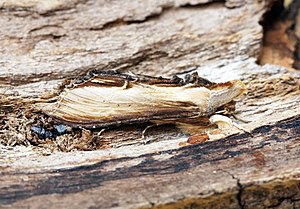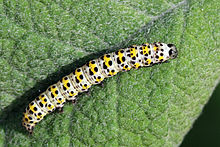Mullein Monk
| Mullein Monk | ||||||||||||
|---|---|---|---|---|---|---|---|---|---|---|---|---|

Mullein Monk ( Cucullia verbasci ) |
||||||||||||
| Systematics | ||||||||||||
|
||||||||||||
| Scientific name | ||||||||||||
| Cucullia verbasci | ||||||||||||
| ( Linnaeus , 1758) |
The mullein monk ( Cucullia verbasci ), also known as the brown monk , is a butterfly ( moth ) from the owl butterfly family (Noctuidae).
features
butterfly
With a wingspan of around 48 to 56 millimeters, the moths are one of the larger species of monk owl. The forewings are from ocher-brown to brown-gray basic color. The inner edge area is dark brown and widens significantly towards the hem. Around the middle of this area are two bright, crescent-shaped characters. A whitish field can be seen above the inner edge. This extends to the outer edge. The hem is strongly jagged, the tip pulled forward. Both the inner and outer transverse lines and all the flaws are very indistinct, but are usually completely absent. The front edge is wide, dark brown to reddish brown and gradually turns into lighter tones inward. The hind wings are strongly jagged at the anal angle, of a brownish color and show clearly recognizable veins. The hood typical of monk owls can be seen on the head and neck, which is formed from hair that is strongly directed forward. There are other short hairs on the abdomen.
egg
The egg is spherical, but flattened at the base and heavily ribbed. It is initially white, later gray in color and then also shows some reddish-yellow spots near the pole.
Caterpillar
Adult caterpillars have a pure white, yellowish white or greenish white basic color. On each segment there is a bright yellow cross band, sometimes broken up into individual spots. A large number of black spots and lines can be seen on the sides and on the back. These are slightly smaller than the very similar caterpillar from the figwort monk , which usually also has a slightly bluish-white basic color. There are some short, thin hairs on the body. The head is large, yellow and has a striking black pattern of spots.
Doll
The doll is colored brown-yellow. The long proboscis sheath is particularly striking.
Similar species
Some similar species from the large number of "brown monks" are selected below:
- Aster monk ( Cucullia asteris )
- Brownwort monk ( Shargacucullia caninae )
- Shargacucullia gozmanyi
- Gray cabbage monk ( Shargacucullia lychnitis )
- Figwort forest monk ( Shargacucullia prenanthis )
- Figwort monk ( Shargacucullia scrophulariae )
- Shargacucullia scrophulariphaga
- Shargacucullia scrophulariphila
- Lost mullein monk ( Shargacucullia thapsiphaga )
Verbasci usually differs from all of the aforementioned species in its larger size, the wider forewings, the broader brown front edge stripes, the very distinctive double crescent moons on the forewings and the generally darker appearance. However, genital morphological examinations should be consulted for a clear determination.
Occurrence and habitat
The species is distributed from northwest Africa across almost all of Europe. However, in the north there are only individual finds from Denmark and southern Finland . The Asian occurrence extends to western Afghanistan . In the Alps it rises to an altitude of 1,600 meters. The mullein monk can mainly be found in dry and warm places, such as steppe heaths, dry grass surfaces, rocky slopes, as well as on wastelands and in parklands.
Way of life
The species forms one generation a year, with the main flight time of the mostly nocturnal moths from mid-April to mid-June. They are strongly attracted to artificial light sources , but they have not been detected on bait . Occasionally they suckle on the flowers of the carnation family (Caryophyllaceae) at dusk . During the day, the moths often sit on branches where they are difficult to see due to their brown color. The hair on the neck collar also simulates a branch break point. The caterpillars feed mainly on various types of mullein ( Verbascum ). These include:
- Small-flowered Mullein ( Verbascum thapsus )
- Black Mullein ( Verbascum nigrum )
- Mealy mullein ( Verbascum lychnitis )
- Flaky Mullein ( Verbascum pulverulentum )
- Windflower Mullein ( Verbascum phlomoides )
- Large-flowered Mullein ( Verbascum densiflorum )
- Cockroach Mullein ( Verbascum Blattaria )
Occasionally the caterpillars have also been found on gnarled figwort ( Scrophularia nodosa ) or butterfly lilac ( Buddleja davidii ), on which they are also easy to breed. Younger caterpillars first feed on the leaves, later on the flowers and fruit clusters. They live from May and pupate in a solid cocoon on the ground in autumn , with the pupae occasionally lying over two years.
Natural enemies
The caterpillars of the mullein monk are parasitized by various brackish wasp species. Their larvae develop inside the caterpillar, eventually kill it and pupate in a separate cocoon outside the caterpillar.
Danger
The mullein monk occurs in very different numbers in the German federal states, but is listed as not endangered on the red list of endangered species .
swell
Individual evidence
- ↑ a b Gábor Ronkay & László Ronkay: Cucullinae I . In: Michael Fibiger, Martin R. Honey, W. Gerald Tremevan (Eds.): Noctuidae Europaeae . tape 6 . Entomological Press, Sorø 1994, ISBN 87-89430-03-4 (English).
- ↑ a b c Walter Forster , Theodor A. Wohlfahrt : The butterflies of Central Europe. Volume 4: Owls. (Noctuidae). Franckh'sche Verlagshandlung, Stuttgart 1971, ISBN 3-440-03752-5 .
- ↑ a b c Günter Ebert (Ed.): The butterflies of Baden-Württemberg . 1st edition. tape 6 . Moth IV. Noctuidae 2nd part. Ulmer, Stuttgart (Hohenheim) 1997, ISBN 3-8001-3482-9 .
- ↑ Federal Agency for Nature Conservation (Ed.): Red List of Endangered Animals in Germany . Landwirtschaftsverlag, Münster 1998, ISBN 3-89624-110-9 .
literature
- Günter Ebert (Ed.): The butterflies of Baden-Württemberg . 1st edition. tape 6 . Moth IV. Noctuidae 2nd part. Ulmer, Stuttgart (Hohenheim) 1997, ISBN 3-8001-3482-9 .
- Gábor Ronkay & László Ronkay: Cucullinae I . In: Michael Fibiger, Martin R. Honey, W. Gerald Tremevan (Eds.): Noctuidae Europaeae . tape 6 . Entomological Press, Sorø 1994, ISBN 87-89430-03-4 (English).
Web links
- Lepiforum e. V. Taxonomy and Photos
- www.schmetterlinge-deutschlands.de Endangerment
- Cucullia verbasci at Fauna Europaea. Retrieved February 24, 2011


